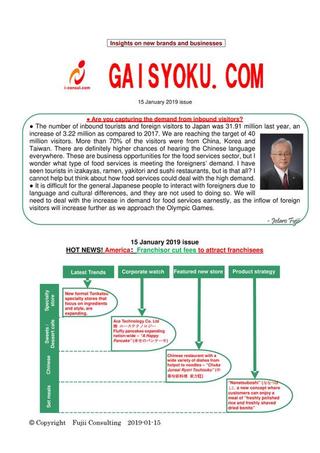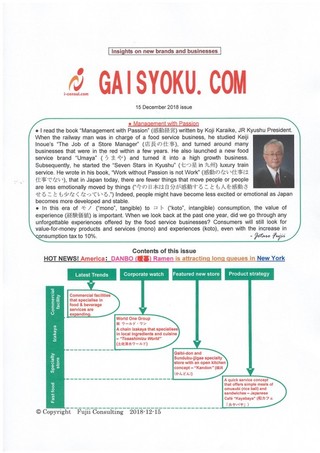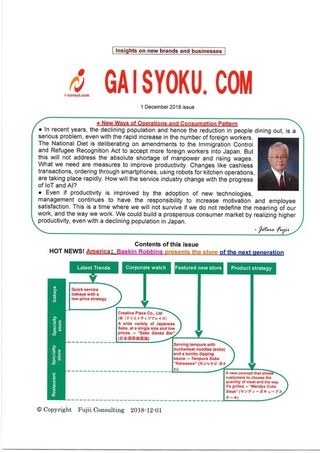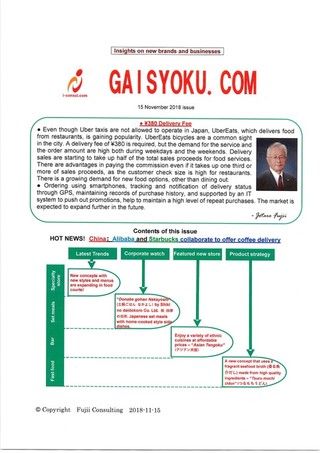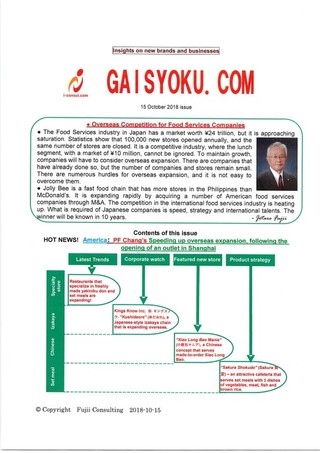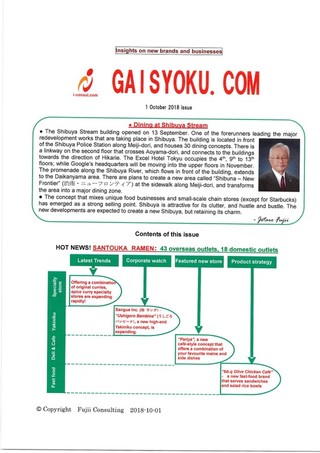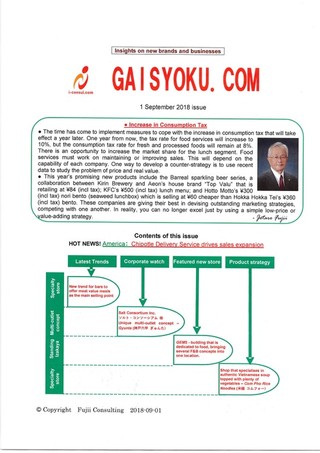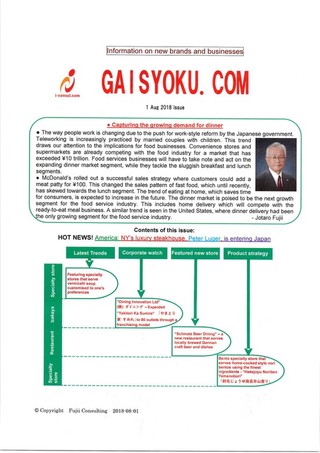i-consul.com|fujii jimusyo|food service consulting|restaurant business|Setagaya, Tokyo

http://i-consul.com/en/
GAISYOKU.COM (Issued twice monthly)
President's column(Serializing in GAISYOKU.COM)
President's column(Serializing in GAISYOKU.COM)
Are you capturing the demand from inbound visitors?
15-Jan-2019
●The number of inbound tourists and foreign visitors to Japan was 31.91 million last year,
an increase of 3.22 million as compared to 2017. We are reaching the target of 40 million visitors.
More than 70% of the visitors were from China, Korea and Taiwan.
There are definitely higher chances of hearing the Chinese language everywhere.
These are business opportunities for the food services sector, but I wonder what type of food services
is meeting the foreigners’ demand. I haveseen tourists in izakayas, ramen, yakitori and sushi restaurants,
but is that all? I cannot help but think about how food services could deal with the high demand.
● It is difficult for the general Japanese people to interact with foreigners due to
language and cultural differences, and they are not used to doing so. We will
need to deal with the increase in demand for food services earnestly, as the inflow of foreign
visitors will increase further as we approach the Olympic Games.
● It is difficult for the general Japanese people to interact with foreigners due to
language and cultural differences, and they are not used to doing so. We will
need to deal with the increase in demand for food services earnestly, as the inflow of foreign
visitors will increase further as we approach the Olympic Games.
|
|
File ( 2010KB ) |
New Food Services Formats to Address Manpower Shortage
01-Jan-2019
● We take a close-up look at the issue of manpower shortage.
The situation is quite serious. It is not a requirement to work 5 days and 8 hours a week anymore,
and age no longer matters.
Wages are rising as a result of the lack of manpower supply, and it has exceeded the usual range for personnel expenses.
The manpower supply is not likely to increase even with the quota for foreign worker visa relaxed.
We could tide over the current situation by using older workers, but there is still a pressing need for us
to develop a system that rely less on manpower, in order to sustain our businesses for the longer run.
● New mechanisms and formats such as electronic ordering panels, cashless and automated operations
and service, will be increasingly adopted. Conveyor belt sushi and buffet have created new demand
for eating out. New and innovative food services formats that combine human service and manpower-saving technologies will be created to address the problem of manpower shortage.
|
|
File ( 2178KB ) |
Management with Passion
15-Dec-2018
● I read the book “Management with Passion” (感動経営) written by Koji Karaike, JR Kyushu President.
When the railway man was in charge of a food service business, he studied Keiji
Inoue’s “The Job of a Store Manager” (店長の仕事), and turned around many
businesses that were in the red within a few years. He also launched a new food
service brand “Umaya” ( うまや) and turned it into a high growth business.
Subsequently, he started the “Seven Stars in Kyushu” (七つ星in 九州) luxury train
service. He wrote in his book, “Work without Passion is not Work” (感動のない仕事は
仕事でない), that in Japan today, there are fewer things that move people or people
are less emotionally moved by things (“今の日本は自分が感動することも人を感動さ
せることも少なくなっている.”) Indeed, people might have become less excited or emotional as Japan
becomes more developed and stable.
● In this era of モノ (“mono”, tangible) to コト (“koto”, intangible) consumption, the value of
experience (経験価値) is important. When we look back at the past one year, did we go through any
unforgettable experiences offered by the food service businesses? Consumers will still look for
value-for-money products and services (mono) and experiences (koto), even with the increase in
consumption tax to 10%.
When the railway man was in charge of a food service business, he studied Keiji
Inoue’s “The Job of a Store Manager” (店長の仕事), and turned around many
businesses that were in the red within a few years. He also launched a new food
service brand “Umaya” ( うまや) and turned it into a high growth business.
Subsequently, he started the “Seven Stars in Kyushu” (七つ星in 九州) luxury train
service. He wrote in his book, “Work without Passion is not Work” (感動のない仕事は
仕事でない), that in Japan today, there are fewer things that move people or people
are less emotionally moved by things (“今の日本は自分が感動することも人を感動さ
せることも少なくなっている.”) Indeed, people might have become less excited or emotional as Japan
becomes more developed and stable.
● In this era of モノ (“mono”, tangible) to コト (“koto”, intangible) consumption, the value of
experience (経験価値) is important. When we look back at the past one year, did we go through any
unforgettable experiences offered by the food service businesses? Consumers will still look for
value-for-money products and services (mono) and experiences (koto), even with the increase in
consumption tax to 10%.
|
|
File ( 2087KB ) |
New Ways of Operations and Consumption Pattern
01-Dec-2018
●In recent years, the declining population and hence
the reduction in people dining out, is a serious problem,
even with the rapid increase in the number of foreign
workers.The National Diet is deliberating on
amendments to the Immigration Control and Refugee
Recognition Act to accept more foreign workers into
Japan. But this will not address the absolute shortage
of manpower and rising wages.
What we need are measures to improve productivity.
Changes like cashless transactions, ordering through
smartphones,using robots for kitchen operations,are
taking place rapidly. How will the service industry
change with the progress of IoT and AI?
● Even if productivity is improved by the adoption of
new technologies, management continues to have the
responsibility to increase motivation and employee
satisfaction. This is a time where we will not survive
if we do not redefine the meaning of our work, and the
way we work.We could build a prosperous consumer
market by realizing higherproductivity, even with a
declining population in Japan.
|
|
File ( 2158KB ) |
¥380 Delivery Fee
15-Nov-2018
● Even though Uber taxis are not allowed to operate in Japan, UberEats, which delivers food from restaurants, is gaining popularity. UberEats bicycles are a common sight in the city. A delivery fee of ¥380 is required, but the demand for the service and the order amount are high both during weekdays and the weekends. Delivery sales are starting to take up half of the total sales proceeds for food services. There are advantages in paying the commission even if it takes up one third or more of sales proceeds, as the customer check size is high for restaurants. There is a growing demand for new food options, other than dining out.
● Ordering using smartphones, tracking and notification of delivery status through GPS, maintaining records of purchase history, and supported by an IT system to push out promotions, help to maintain a high level of repeat purchases. The market is expected to expand further in the future.
● Ordering using smartphones, tracking and notification of delivery status through GPS, maintaining records of purchase history, and supported by an IT system to push out promotions, help to maintain a high level of repeat purchases. The market is expected to expand further in the future.
|
|
File ( 1919KB ) |
Build your strengths
01-Nov-2018
● It is not easy to survive in a competitive food services market. It is even more so in an ever-changing environment. Shimokitazawa is a city of fierce battle. But from the second half of the year, the queues of curry restaurants are growing by the day. There have always been many curry restaurants in Shimokitazawa. Magic Spice is an example of a popular and established curry restaurant there. However, we are seeing more new players overtaking these established brands. They include Kyuyamutei Shimokitasou (旧ヤム邸 シモキタ荘). You will smell a strong spice fragrance as you leave the southwest exit of the station and walk towards the store.
● Most customers are couples and women in their 20s. Customers will usually have to wait in the queue for more than an hour as the store is small with limited seats. It is located within a 5-minute walk from the station, and 15 minutes from Fujii Consulting office. The queue is a common sight that we see every day. This situation is only possible for stores that offer delicious food and possess certain strengths. It is the time of year for us to reflect on what we need to improve for our food businesses.
● Most customers are couples and women in their 20s. Customers will usually have to wait in the queue for more than an hour as the store is small with limited seats. It is located within a 5-minute walk from the station, and 15 minutes from Fujii Consulting office. The queue is a common sight that we see every day. This situation is only possible for stores that offer delicious food and possess certain strengths. It is the time of year for us to reflect on what we need to improve for our food businesses.
|
|
File ( 2142KB ) |
Overseas Competition for Food Services Companies
15-Oct-2018
● The Food Services industry in Japan has a market worth ¥24 trillion, but it is approaching saturation. Statistics show that 100,000 new stores opened annually, and the same number of stores are closed. It is a competitive industry, where the lunch segment, with a market of ¥10 million, cannot be ignored.To maintain growth,companies will have to consider overseas expansion. There are companies that have already done so, but the number of companies and stores remain small.There are numerous hurdles for overseas expansion, and it is not easy to overcome them.
● Jolly Bee is a fast food chain that has more stores in the Philippines than McDonald’s. It is expanding rapidly by acquiring a number of American food services companies through M&A. The competition in the international food services industry is heating up. What is required of Japanese companies is speed, strategy and international talents. Thewinner will be known in 10 years.
● Jolly Bee is a fast food chain that has more stores in the Philippines than McDonald’s. It is expanding rapidly by acquiring a number of American food services companies through M&A. The competition in the international food services industry is heating up. What is required of Japanese companies is speed, strategy and international talents. Thewinner will be known in 10 years.
|
|
File ( 2520KB ) |
Dining at Shibuya Stream
01-Oct-2018
● The Shibuya Stream building opened on 13 September. One of the forerunners leading the major
redevelopment works that are taking place in Shibuya. The building is located in front
of the Shibuya Police Station along Meiji-dori, and houses 30 dining concepts. There is
a linkway on the second floor that crosses Aoyama-dori, and connects to the buildings
towards the direction of Hikarie. The Excel Hotel Tokyu occupies the 4th, 9th to 13th
floors; while Google’s headquarters will be moving into the upper floors in November.
The promenade along the Shibuya River, which flows in front of the building, extends
to the Daikanyama area. There are plans to create a new area called “Shibuna – New
Frontier” (渋南・ニューフロンティア) at the sidewalk along Meiji-dori, and transforms
the area into a major dining zone.
● The concept that mixes unique food businesses and small-scale chain stores (except for Starbucks)
has emerged as a strong selling point. Shibuya is attractive for its clutter, and hustle and bustle. The
new developments are expected to create a new Shibuya, but retaining its charm.
redevelopment works that are taking place in Shibuya. The building is located in front
of the Shibuya Police Station along Meiji-dori, and houses 30 dining concepts. There is
a linkway on the second floor that crosses Aoyama-dori, and connects to the buildings
towards the direction of Hikarie. The Excel Hotel Tokyu occupies the 4th, 9th to 13th
floors; while Google’s headquarters will be moving into the upper floors in November.
The promenade along the Shibuya River, which flows in front of the building, extends
to the Daikanyama area. There are plans to create a new area called “Shibuna – New
Frontier” (渋南・ニューフロンティア) at the sidewalk along Meiji-dori, and transforms
the area into a major dining zone.
● The concept that mixes unique food businesses and small-scale chain stores (except for Starbucks)
has emerged as a strong selling point. Shibuya is attractive for its clutter, and hustle and bustle. The
new developments are expected to create a new Shibuya, but retaining its charm.
|
|
File ( 1947KB ) |
Increase in Consumption Tax
01-Sep-2018
● The time has come to implement measures to cope with the increase in consumption tax that will take
effect a year later. One year from now, the tax rate for food services will increase to 10%, but the consumption tax rate for fresh and processed foods will remain at 8%.There is an opportunity to increase the market share for the lunch segment. Food services must work on maintaining or improving sales. This will depend on the capability of each company. One way to develop a counter-strategy is to use recent
data to study the problem of price and real value.
● This year’s promising new products include the Barreal sparkling beer series, a collaboration between Kirin Brewery and Aeon’s house brand “Top Valu” that is retailing at ¥84 (incl tax); KFC’s ¥500 (incl tax) lunch menu; and Hotto Motto’s ¥300 (incl tax) nori bento (seaweed lunchbox) which is selling at ¥60 cheaper than Hokka Hokka Tei’s ¥360 (incl tax) bento. These companies are giving their best in devising outstanding marketing strategies, competing with one another. In reality, you can no longer excel just by using a simple low-price or value-adding strategy.
effect a year later. One year from now, the tax rate for food services will increase to 10%, but the consumption tax rate for fresh and processed foods will remain at 8%.There is an opportunity to increase the market share for the lunch segment. Food services must work on maintaining or improving sales. This will depend on the capability of each company. One way to develop a counter-strategy is to use recent
data to study the problem of price and real value.
● This year’s promising new products include the Barreal sparkling beer series, a collaboration between Kirin Brewery and Aeon’s house brand “Top Valu” that is retailing at ¥84 (incl tax); KFC’s ¥500 (incl tax) lunch menu; and Hotto Motto’s ¥300 (incl tax) nori bento (seaweed lunchbox) which is selling at ¥60 cheaper than Hokka Hokka Tei’s ¥360 (incl tax) bento. These companies are giving their best in devising outstanding marketing strategies, competing with one another. In reality, you can no longer excel just by using a simple low-price or value-adding strategy.
|
|
File ( 2307KB ) |
Capturing the growing demand for dinner
01-Aug-2018
● The way people work is changing due to the push for work-style reform by the Japanese government.
Teleworking is increasingly practiced by married couples with children. This trend draws our attention to the implications for food businesses. Convenience stores and supermarkets are already competing with the food industry for a market that has exceeded ¥10 trillion. Food services businesses will have to take note and act on the expanding dinner market segment, while they tackle the sluggish breakfast and lunch segments.
● McDonald’s rolled out a successful sales strategy where customers could add a meat patty for ¥100. This changed the sales pattern of fast food, which until recently,has skewed towards the lunch segment. The trend of eating at home, which saves time for consumers, is expected to increase in the future. The dinner market is poised to be the next growth segment for the food service industry. This includes home delivery which will compete with the ready-to-eat meal business. A similar trend is seen in the United States, where dinner delivery had been the only growing segment for the food service industry.
Teleworking is increasingly practiced by married couples with children. This trend draws our attention to the implications for food businesses. Convenience stores and supermarkets are already competing with the food industry for a market that has exceeded ¥10 trillion. Food services businesses will have to take note and act on the expanding dinner market segment, while they tackle the sluggish breakfast and lunch segments.
● McDonald’s rolled out a successful sales strategy where customers could add a meat patty for ¥100. This changed the sales pattern of fast food, which until recently,has skewed towards the lunch segment. The trend of eating at home, which saves time for consumers, is expected to increase in the future. The dinner market is poised to be the next growth segment for the food service industry. This includes home delivery which will compete with the ready-to-eat meal business. A similar trend is seen in the United States, where dinner delivery had been the only growing segment for the food service industry.
|
|
File ( 1981KB ) |



